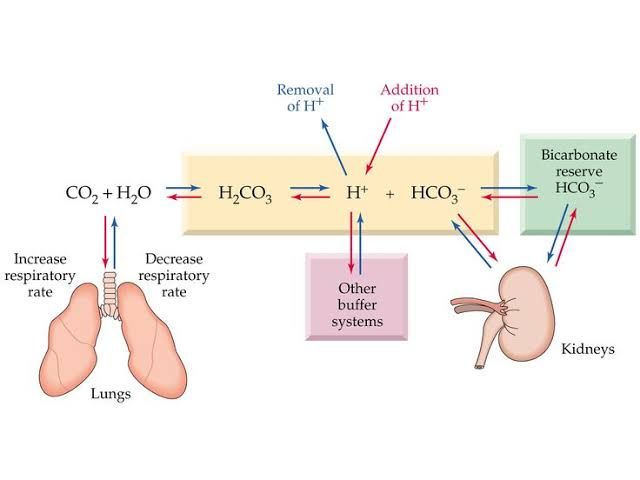
The Bicarbonate Buffer System
The bicarbonate buffer system is a critical acid-base homeostatic mechanism that maintains the pH of blood and other tissues within a narrow range, typically around 7.35–7.45. This system involves the equilibrium between carbon dioxide (CO2), carbonic acid (H2CO3), bicarbonate ions (HCO3⁻), and hydrogen ions (H⁺). The reaction can be summarized as follows:
(CO2 + H2O ⇌ H2CO3 ⇌ HCO3⁻ + H⁺)
- Mechanism of Action:
- Carbon dioxide (CO2) produced by cellular respiration diffuses into the blood and reacts with water (H2O) to form carbonic acid (H2CO3). This reaction is catalyzed by the enzyme carbonic anhydrase, which is present in red blood cells.
- Carbonic acid is a weak acid that rapidly dissociates into bicarbonate ions (HCO3⁻) and hydrogen ions (H⁺).
- The balance between these components helps neutralize excess acids or bases introduced into the bloodstream.
- Regulation of pH:
- The ratio of bicarbonate to carbonic acid must remain approximately 20:1 to maintain a normal blood pH of 7.4. This balance is regulated by respiratory compensation (via the lungs) and renal compensation (via the kidneys).
- In response to increased acidity, bicarbonate ions neutralize excess H⁺, forming more carbonic acid, which then converts back to CO2 and is exhaled.
- Conversely, if there is an excess base, carbonic acid donates H⁺ to restore balance.
- Failure of the System:
- Disruption in this system leads to conditions such as acidosis (pH < 7.35) or alkalosis (pH > 7.45), depending on whether there is an excess of hydrogen ions or a deficit.
Biochemical Changes in Respiratory Acidosis and Alkalosis
Respiratory Acidosis
Respiratory acidosis occurs when there is an accumulation of CO2 in the blood due to hypoventilation or impaired gas exchange, leading to decreased blood pH.
- Primary Cause:
- Increased partial pressure of CO2 (pCO2) in arterial blood due to inadequate ventilation or lung dysfunction.
- Biochemical Changes:
- Elevated CO2 reacts with water to form more carbonic acid: (CO2 + H2O → H2CO3 → HCO3⁻ + H⁺)
- Increased concentration of hydrogen ions lowers pH.
- Acute buffering occurs intracellularly via proteins like hemoglobin binding excess hydrogen ions.
- Chronic compensation involves renal mechanisms where kidneys increase reabsorption of bicarbonate and excrete hydrogen ions over days.
- Clinical Examples:
- Conditions such as chronic obstructive pulmonary disease (COPD), severe asthma, or drug-induced respiratory depression can lead to respiratory acidosis.
Respiratory Alkalosis
Respiratory alkalosis occurs when excessive loss of CO2 from hyperventilation raises blood pH above normal levels.
- Primary Cause:
- Decreased partial pressure of CO2 due to rapid breathing or hyperventilation caused by anxiety, fever, pregnancy, or mechanical ventilation.
- Biochemical Changes:
- Reduced CO2 levels shift the equilibrium leftward: (CO2 + H2O ← H2CO3 ← HCO3⁻ + H⁺)
- Decreased hydrogen ion concentration raises pH.
- Intracellular buffers release hydrogen ions; hemoglobin plays a role here by releasing bound protons.
- Over time, kidneys compensate by increasing excretion of bicarbonate and retaining hydrogen ions.
- Clinical Examples:
- Panic attacks, high altitudes causing hypoxia-induced hyperventilation, or iatrogenic causes like excessive mechanical ventilation can result in respiratory alkalosis.
Role of Hemoglobin in the Buffer System
Hemoglobin plays a vital role as an intracellular buffer within red blood cells during both respiratory acidosis and alkalosis:
- Buffering Hydrogen Ions:
- Hemoglobin binds free hydrogen ions generated during CO₂ transport in red blood cells. Deoxyhemoglobin has a higher capacity for binding protons compared to oxyhemoglobin because it releases oxygen at tissues where CO₂ levels are high. This buffering prevents significant drops in intracellular pH despite elevated CO₂ levels during respiratory acidosis.
Reaction: (Hb-O₂ → Hb-H)
- Carbamino Compound Formation:
- Hemoglobin also directly binds CO₂ at its amino groups, forming carbaminohemoglobin compounds that facilitate CO₂ transport from tissues back to the lungs for exhalation. This process indirectly contributes to maintaining systemic pH balance since it reduces free circulating CO₂ levels.
- Chloride Shift Mechanism: During gas exchange at tissues and lungs, hemoglobin facilitates the chloride shift (Hamburger effect):
- At tissues: Bicarbonate exits red blood cells into plasma in exchange for chloride ions entering cells.
- At lungs: The reverse occurs—bicarbonate re-enters red cells for conversion back into CO₂ for exhalation.
This dynamic exchange ensures efficient buffering while maintaining ionic balance across cell membranes.







